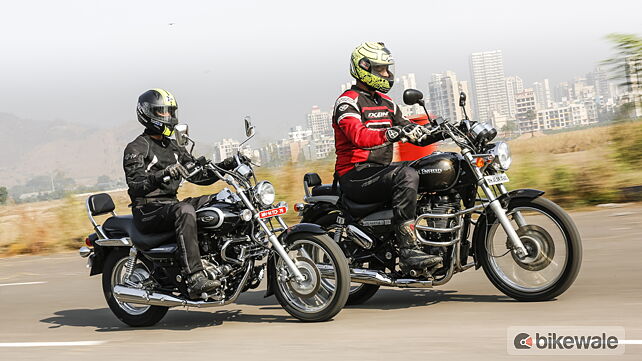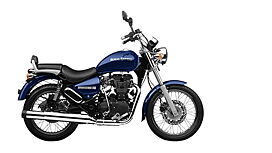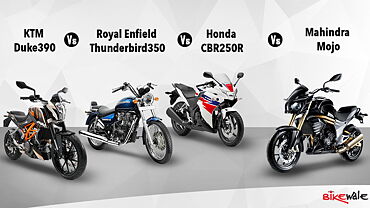Introduction

We brought you the comparison between the Avenger 150 and the Suzuki Gixxer SF a few weeks back (you can read it HERE). So, while the Avenger 150 is a new category for Bajaj to enter, it has been operating with the 220cc engine for eons. But, the motorcycle’s sales had stopped growing. Its competitor on the other hand, the Royal Enfield range of bikes has been growing in numbers and strength with every passing month. So, to tackle this, Bajaj is now offering the Avenger 220 in two forms – the Street and the Cruise. The Cruise, as its name suggests, is meant for touring along with being a bike for the daily grind; a need the Thunderbird 350 currently addresses. Enough reason really for us to compare the two to find out which deserves to be in your garage.
Design & Style

When it comes to design, the two are very different. The Avenger 220 Cruise looks more laid back and sober, while the Thunderbird 350 gets the bulky macho look. We like the latter. Now, while the low seat height and high handlebar of the Cruise is seen as a style statement by many, the Thunderbird 350 with its large tank, wider seat and more upright riding position, is seen as the more serious touring machine. The Royal Enfield name helps too.


Chrome is something that’s abundant on both the bikes but Bajaj has smartly used it on components, which are easily visible to the naked eyes. On the other hand, Royal Enfield wanted to showcase the bulky nature of the bike, hence, went little lighter with the chrome application. Also, such traditional design demands spoke wheels and both the bikes fulfil it.
Avenger 220: 7/10
Thunderbird 350: 8/10
Ergonomics & Quality

The ergonomics for the Avenger 220 and the Thunderbird 350 is just about OK. Both are reasonably comfortable on long rides as well as within the city. Between the two, the Avenger works better. It's low but the comfortable seat, the wide spread and easy to hold bars make long distance travel easy. The Thunderbird has a poor seat design. So, in less than an hour, it begins to feel uncomfortable. Otherwise, the handlebar-seat-footpeg position is nearly as comfortable as the Bajaj. But, where the Thunderbird manages to score more is quality. It’s not everyday that one reads about an RE surpassing a Bajaj on the quality front, but it is true here. The switchgear and the overall fit and finish are better on the RE. The difference isn’t much, but it is telling.
Avenger 220: 6.5/10
Thunderbird 350: 7/10
Features & Technology

The Avenger 220 Cruise retains the same instrument cluster from the outgoing Avenger 220. Nothing much has changed on this front. It gets the same round speedometer, which gets an integrated trip meter and odometer. Along with this, there is a tank-mounted cluster as well, that features the fuel indicator, turn and neutral indicators.

The Thunderbird 350 gets a well laid out twin-pod cluster that shows all the information that the Avenger 220 Cruise does. But, this Royal Enfield shows the average speed as well and that’s a plus point. Also, the bike has the option to switch on the hazard lamps, which can be done via a small button placed between the twin-pod clusters.

In terms of hardware, the Thunderbird 350 scores more than the Bajaj. It gets a projector headlamp, which is of great use. The 240mm single disc is standard on the Thunderbird 350, whereas a 130mm rear drum brake does the duty on the Avenger 220 Cruise. You are limited to only one colour option for the Avenger whereas the Thunderbird 350 could be chosen from four different paint schemes.
Avenger 220: 6/10
Thunderbird 350: 7/10
Engine & Gearbox

This is where you will find the major difference in terms of figures and on road manners. The Avenger 220 Cruise has a street bike heart – an oversquare 220cc single that produces 19bhp and 17.5Nm. Both these figures are produced at relatively high engine rpm. The gearbox is a five-speed unit. So, on the road, the Avenger feels lighter, racier and more fun to ride – as much fun a tall handled, low seat bike can get. It’s not a refined engine, but compared to the Thunderbird, it feels so. The rideability and the acceleration are both significantly better on the Bajaj.

The Thunderbird 350, as the name suggests, uses a 350cc motor. Like the Avenger, it too is a single, air-cooled unit but it uses a much longer stroke. This, along with the larger capacity gives the RE a huge torque advantage. It makes 28Nm. The max power however, is only up on the Avenger by 1bhp. Plus, at 192kg the Thunderbird is heavy. No wonder it is slower in the real world. Plus, it vibrates more, has lazier throttle response and is overall less fun to ride.
Avenger 220: 7/10
Thunderbird 350: 6/10
Performance

Like we said before, the Avenger 220 Cruise gets its engine from the Pulsar 220F, which is a naked bike. The engine characteristics of the naked were to suit the needs of quick acceleration and a good top speed. And the Avenger Cruise 220 behaves the same. It lacks low-end torque, due to the oversquare layout. The bike is quick and won’t disappoint you at the traffic signal, but from a cruiser you expect a good amount of torque at the lower revs, which the Avenger doesn’t fulfil. Vibrations are still present and can be felt starting from 65kmph but as you go up the revs, you are bound to curse that thought.
The Thunderbird 350 has just 0.5bhp more than the Avenger, but has almost 10Nm of torque over the Bajaj. This makes the overall performance better right? Wrong. This engine is pretty old, so are the characteristics. Also, don’t forget that the bike weighs 192kg, and that’s a big number to handle. There are enough vibes on the bike to cut short your ride. Cruising between 80kmph and 90kmph is possible but go above that and you will experience vibrations on the handlebar, tank and foot pegs.
Avenger 220: 7/10
Thunderbird 350: 6/10
Ride Quality

The suspension setup for both the bikes is taken care of by telescopic fork at the front and twin shock absorbers at the rear. But the Avenger is better tuned for city surfaces as it takes small and large potholes with ease. The well-cushioned seats further help with the overall comfort. The Thunderbird 350’s ride isn’t as plush as the Bajaj's. It’s not absorbent and with poorly designed seat, the bike on a poor road can take a toll on your back.
Avenger 220:7.5/10
Thunderbird 350: 6/10
Handling & Braking

This is again where the Avenger 220 Cruise outscores the Thunderbird 350. The Avenger is planted in a straight line; feels lighter and surer turning into corners; doesn’t skip around when leaned over; and has a more communicative chassis and tyre setup. The Avenger is also easier to ride in the city and it has much better braking as well.
The Thunderbird’s brakes feel wooden. There’s hardly any feel or bite, plus the bike feels heavy, lazy and mute compared to the Avenger around a set of corners. It’s a huge step forward compared to older bullets, but compared to the Bajaj, it still has some distance to cover. The weight again plays spoilsport here.
Avenger 220:6/10
Thunderbird 350: 4/10
Fuel Efficiency

There is a difference of almost 40kg between the two bikes and the result is seen in the fuel efficiency figures. The Bajaj Avenger 220 Cruise returned 53kmpl, impressive for its size and weight. The Thunderbird 350, which is both heavier and larger, expectedly returned a lower fuel efficiency figure. But 25kmpl under same test conditions was a lot lower than our expectations.
Avenger 220: 6/10
Thunderbird 350: 4/10
Price & Warranty

There is a price difference of almost Rs 65,000 between these two bikes. The Avenger 220 Cruise will empty your bank account by Rs 95,985 (on-road Mumbai), whereas the Thunderbird 350 will hurt you by Rs 1,60,801 (on-road Mumbai). For 65,000 more, you get a bigger, torquier engine; better overall quality; and way more street presence.
Avenger 220: 7.5/10
Thunderbird 350: 5/10
Desirability

The Royal Enfield Thunderbird 350, period.
Avenger 220: 7/10
Thunderbird 350: 8/10
Verdict

Let’s not forget that the Indian market still doesn’t have a lot of affordable cruisers. And between the two that we do have, we’d say the Bajaj Avenger 220 Cruise is the better proposition. The Thunderbird only makes sense if you want street cred and a bigger engine to boast about, because for everything else, there’s the Avenger. The Bajaj offers better value, is lower priced, is more efficient and on the crucial front of munching miles, is almost as good if not better than the RE. The Avenger 220 Cruise is our winner.
Photography by Kapil Angane
Final Scores
| Parameters/Models | Max Points | Bajaj | Royal Enfield |
| Avenger 220 Cruise | Thunderbird 350 | ||
| Rank | 1 | 2 | |
| Looks & Styling | 10 | 7 | 8 |
| Ergonomics & Quality | 10 | 6.5 | 7 |
| Features & Technology | 10 | 6 | 7 |
| Engine & Gearbox | 10 | 7 | 6 |
| Performance | 10 | 7 | 6 |
| Ride quality | 10 | 7.5 | 6 |
| Handling & Braking | 10 | 6 | 4 |
| Fuel Efficiency | 10 | 6 | 4 |
| Price & Warranty | 10 | 7.5 | 5 |
| Desirablility | 10 | 7 | 8 |
| Total | 100 | 67.5 | 61 |
Specifications
| MAKE | Bajaj | Royal Enfield |
| Model | Avenger 220 Cruise | Thunderbird 350 |
| POWERTRAIN | ||
| Engine Type | Oil-cooled | Air-cooled |
| Capacity | 220cc | 346cc |
| Max Power | 19.03bhp | 19.8bhp |
| Max Torque | 17.5Nm | 28Nm |
| Gearbox | 5 speed | 5 speed |
| Clutch | Wet, multiplate | Wet, multiplate |
| Fuel Efficiency (Tested) | 53kmpl | 25kmpl |
| CYCLE PARTS | ||
| Chassis | Tubular Double Cradle | Single downtube |
| Supension F | Telescopic | Telescopic |
| Suspension R | Twin Shock Absorber | Twin gas charged shock absorbers with 5-step |
| Brakes F | 260mm disc | 280mm disc |
| Brakes R | 130mm drum | 240mm disc |
| Tyre F | 90/90-17 Tubed | 90/90-19 Tubeless |
| Tyre R | 130/90-15 Tubed | 120/80-18 Tubeless |
| MEASURES | ||
| Fuel Tank | 14 litres | 20 litres |
| LxWxH | 2177mm x 806mm x 1142mm | 2060mm x 790mm x 1205mm |
| Wheelbase | 1490mm | 1350mm |
| Kerb Weight | 155kg | 192kg |
| COST | ||
| Price (on-road, Mumbai) | Rs 95,985 | Rs 1,60,389 |
| Warranty | 2 years/30,000kms | 2 year/20,000kms |
Gallery
1/72
Bajaj Avenger 220 Cruise vs Royal Enfield Thunderbird 350
Double Tap to Zoom

















































![KTM 390 Adventure X [2025] KTM 390 Adventure X [2025]](https://imgd.aeplcdn.com/272x153/n/cw/ec/190885/390-adventure-x-2025-right-side-view.jpeg?isig=0&q=80)